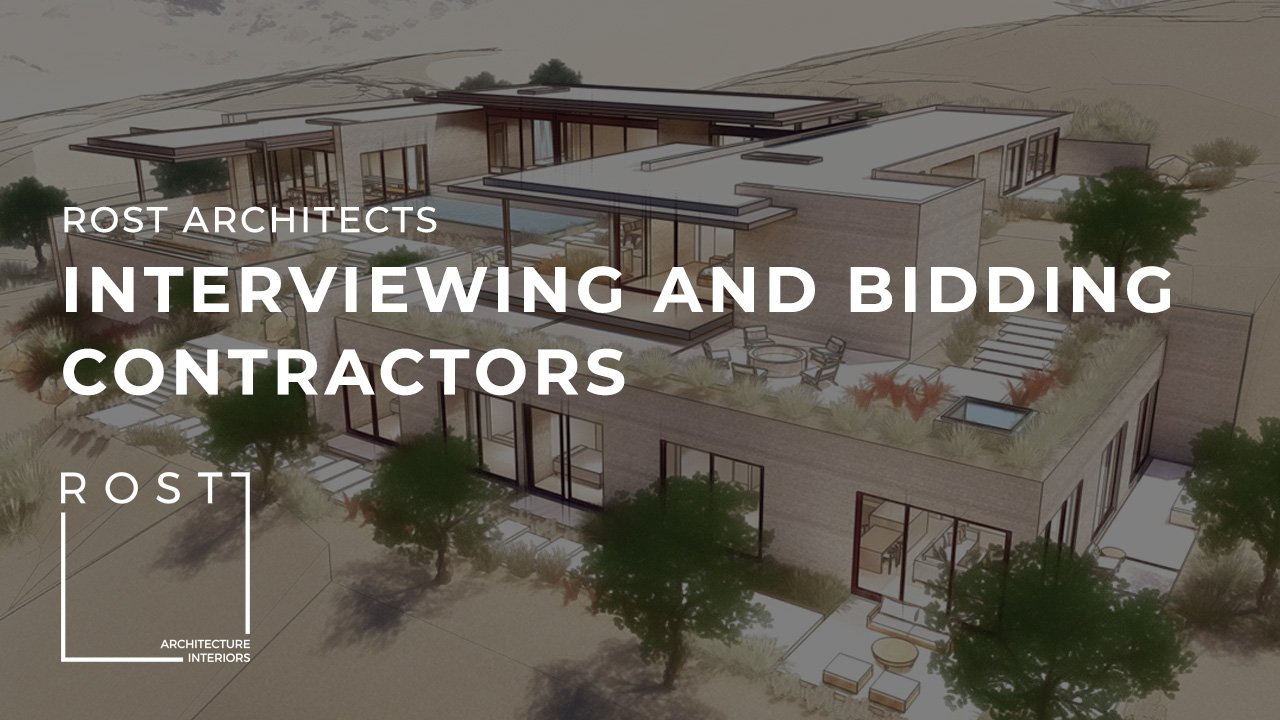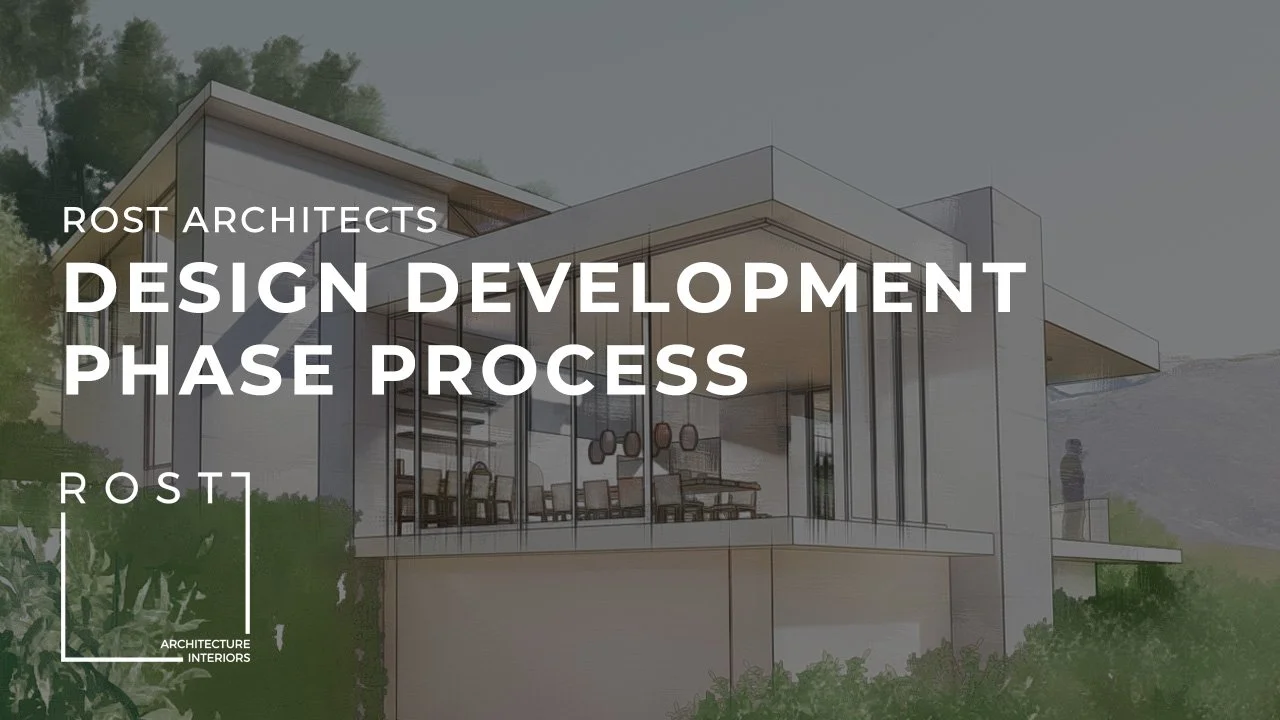Rost Architects - Contractor Bidding Process

With each project it is critical to have a qualified, competent and experienced builder to construct the home. The quality of the builder will drastically effect the construction experience and outcome of the home. Over the years, we have developed a group of builders that we like to build our homes. Likewise, we have worked with builders who we would not recommend to our clients.
The process of interviewing, bidding and hiring a contractor can be complex and long. We prefer to be heavily involved in this process as representatives to the owners. Ultimately, it will be the owners choice on which contractor that they would like to work with based on budget and personal preference, however we can provide significant value and help guide our clients to making an educated, well informed decision.
What does an architect do during the bidding phase?
Provide Introductions to Builders
As mentioned above, we have worked with many contractors in our local market. We can provide our clients with feedback on our experience working with each group. We will make introductions to those contractors and introduce them to the project. In this stage, a good practice is to organize visits where the owner can see project under construction or finished work by the builder to see the quality, site management and meet internal staff.
Assemble and Distribute Instructions to Bidders Package
Your architectural team can assemble a package that includes the plans, project renders, flythrough to each bidding contractor. Along with the project documents, we typically send out a contractor qualification package, a bidding template, and provide a schedule for bidding. The bid template is a key tool to make analyzing or “leveling the bids” much easier.
The purpose of a bid template is to have each bidding contractor format their bids in the same way. This makes it easier to compare and “level bids.” If a bid template is not used, each of the bidding contractors will use their own format and it make it incredibly difficult to make an “apples to apples” comparison. With a bid template, each contractor will be required to place their numbers for each category of work on the same line in the bid.
Respond to any questions the bidding contractors may have
During the bidding process, each bidder will have questions about the project. We typically will conduct a series of meetings with each bidder to answer their questions and add/clarify information in the plan set. During the meetings we will ask the bidders questions as well to make sure that they have studied the drawings and are aware of the expected quality. It is relatively easy to decipher how well the contractor has studied the drawings and his level of competency in executing the details that we have drawn in the construction set.
Issue Addenda to the drawings
If a contractor points requests additional information or asks for additional details to help refine his/her pricing, most likely another bidding contractor will have these same questions. In the bidding process we will assemble all of the additional drawings. details and responses that each bidding contractor asked and integrate them into the construction set as an addenda. This updated set will be re-issued to each bidding contractor for them to modify pricing.
Review and Level Bids
On receipt of all bids, our team will begin our leveling process. As mentioned above, this process is much easier if all bids are formatted in our bid template. During this process we will make sure that each contractor has all the scope in the drawings accounted for.
After the design and engineering are complete, permits are secured, and a General Contractor agreement is established, the next phase of the project is construction. During the construction of a home, an Architect will offer Construction Administration or “CA” services. Below is an outline of the typical Construction Administration services that your Architect will offer during the Construction phase of your home
With each project it is critical to have a qualified, competent and experienced builder to construct the home. The quality of the builder will drastically effect the construction experience and outcome of the home. Check out the article to read more about what an Architect does during the bidding process to help the owner select the right builder for the job.
The Construction Documentation phase of the project is customarily the third phase in a typical project. The “CD” or Construction Documentation phase is exactly what it says, the Architectural team will be producing the documents that will be used during construction to build the home. (To learn more about the preceding phases, Schematic Design and Design Development, click on the respective links.)
Recently Rost Architects invested in a large format high resolution 3D Printer for the office. We are now offering 3D printing to all of our clients on their custom home projects. To learn more about how to 3D print your home, check out our article. We hope you enjoy.
The design development phase of a project is the pivotal phase where the design starts to become real. During this phase, the Architectural team takes the owner approved schematic design and dives deeper into the more technical related components of the building, continues to refine the design from many different angles. This article highlights the key tasks that our team will be working on during the design development phase of your custom home project.
The customary Architectural Services are typically divided into four phases. They are; Schematic Design, Design Development, Construction Documents, and Construction Administration. The Schematic Design phase of the project is the first phase of the project and in our opinion one of the most important phases. Check out our article to learn more about this phase of a project.
Do you need an interior designer for your project? Are you unsure of how the design firm will work? Do you want more information on the process you can expect during the design? We’ve assembled this article with hopes to bring clarity to the process. We hope this will make the process feel less daunting and give you a road map for what to expect when working with our interior design team.
Thinking about designing and building a custom home? To successfully complete your project, many different people will need to be involved and bring their individual expertise to the table. The quality of your project team will largely determine the outcome of your home.
Working with a hybrid architectural & interior design firm has many advantages. When we created ROST, our vision was to create a firm that delivered one complete comprehensive building design with the interior and exterior tightly coordinated, thoughtfully designed and seamlessly unified into one aesthetic vision.
Working with a hybrid architecture and interior design firm has many benefits. Our interior design team and architecture team work closely together to develop projects with a cohesive design on both the interior and exterior of the building.
Do you want to build a custom home? Learn about the major milestones in the construction process. This article gives a general breakdown of the process for homeowners.
Take a tour through the Rost Architects studio. We spend a lot of time here working hard for our clients. We are grateful to be doing work we love in such a beautiful space.
In May 2019, Rost Architects was featured on CBS “This is L.A.” The film crew came into our office to see how we work, talk about recent projects and meet the team. It was a great experience and we were thrilled to be featured on the program.
Drone video showing the concrete pour for one of our custom homes in Newport Beach. Steel is being fabricated. Looking forward to seeing this one come to life. #customhomes #modernarchitecture #rostarchitects#newportbeach
Watch Rost Architects interview on the the typical project process for designing a custom home.
Watch Rost Architects interview about the benefits of hiring a firm for your project that provides both architectural and interior design services under one roof.
Watch Rost Architects interview about how we begin the design process using site and context.






















